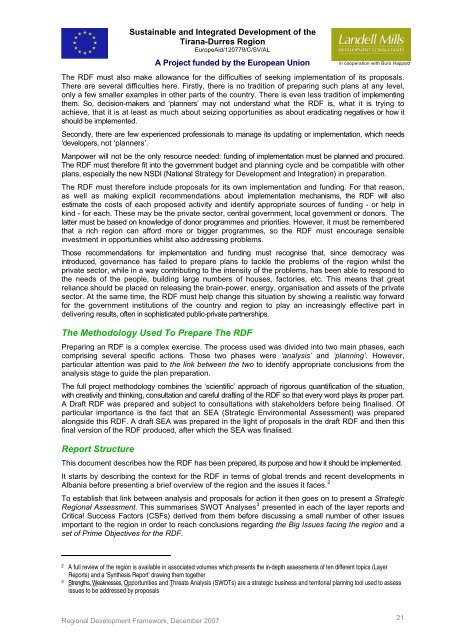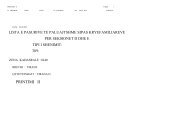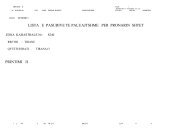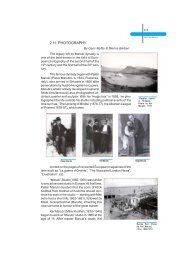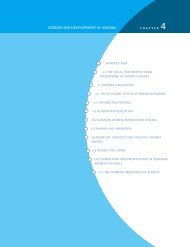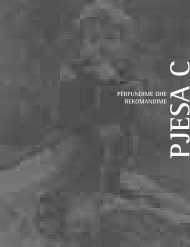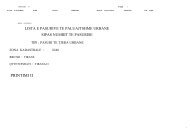Durres Tirana Corridor (PDF) - Sustainable Economic Development ...
Durres Tirana Corridor (PDF) - Sustainable Economic Development ...
Durres Tirana Corridor (PDF) - Sustainable Economic Development ...
Create successful ePaper yourself
Turn your PDF publications into a flip-book with our unique Google optimized e-Paper software.
<strong>Sustainable</strong> and Integrated <strong>Development</strong> of the<br />
<strong>Tirana</strong>-<strong>Durres</strong> Region<br />
EuropeAid/120779/C/SV/AL<br />
A Project funded by the European Union<br />
in cooperation with Buro Happold<br />
The RDF must also make allowance for the difficulties of seeking implementation of its proposals.<br />
There are several difficulties here. Firstly, there is no tradition of preparing such plans at any level,<br />
only a few smaller examples in other parts of the country. There is even less tradition of implementing<br />
them. So, decision-makers and ‘planners’ may not understand what the RDF is, what it is trying to<br />
achieve, that it is at least as much about seizing opportunities as about eradicating negatives or how it<br />
should be implemented.<br />
Secondly, there are few experienced professionals to manage its updating or implementation, which needs<br />
‘developers, not ‘planners’.<br />
Manpower will not be the only resource needed: funding of implementation must be planned and procured.<br />
The RDF must therefore fit into the government budget and planning cycle and be compatible with other<br />
plans, especially the new NSDI (National Strategy for <strong>Development</strong> and Integration) in preparation.<br />
The RDF must therefore include proposals for its own implementation and funding. For that reason,<br />
as well as making explicit recommendations about implementation mechanisms, the RDF will also<br />
estimate the costs of each proposed activity and identify appropriate sources of funding - or help in<br />
kind - for each. These may be the private sector, central government, local government or donors. The<br />
latter must be based on knowledge of donor programmes and priorities. However, it must be remembered<br />
that a rich region can afford more or bigger programmes, so the RDF must encourage sensible<br />
investment in opportunities whilst also addressing problems.<br />
Those recommendations for implementation and funding must recognise that, since democracy was<br />
introduced, governance has failed to prepare plans to tackle the problems of the region whilst the<br />
private sector, while in a way contributing to the intensity of the problems, has been able to respond to<br />
the needs of the people, building large numbers of houses, factories, etc. This means that great<br />
reliance should be placed on releasing the brain-power, energy, organisation and assets of the private<br />
sector. At the same time, the RDF must help change this situation by showing a realistic way forward<br />
for the government institutions of the country and region to play an increasingly effective part in<br />
delivering results, often in sophisticated public-private partnerships.<br />
The Methodology Used To Prepare The RDF<br />
Preparing an RDF is a complex exercise. The process used was divided into two main phases, each<br />
comprising several specific actions. Those two phases were ‘analysis’ and ‘planning’. However,<br />
particular attention was paid to the link between the two to identify appropriate conclusions from the<br />
analysis stage to guide the plan preparation.<br />
The full project methodology combines the ‘scientific’ approach of rigorous quantification of the situation,<br />
with creativity and thinking, consultation and careful drafting of the RDF so that every word plays its proper part.<br />
A Draft RDF was prepared and subject to consultations with stakeholders before being finalised. Of<br />
particular importance is the fact that an SEA (Strategic Environmental Assessment) was prepared<br />
alongside this RDF. A draft SEA was prepared in the light of proposals in the draft RDF and then this<br />
final version of the RDF produced, after which the SEA was finalised.<br />
Report Structure<br />
This document describes how the RDF has been prepared, its purpose and how it should be implemented.<br />
It starts by describing the context for the RDF in terms of global trends and recent developments in<br />
Albania before presenting a brief overview of the region and the issues it faces. 2<br />
To establish that link between analysis and proposals for action it then goes on to present a Strategic<br />
Regional Assessment. This summarises SWOT Analyses 3 presented in each of the layer reports and<br />
Critical Success Factors (CSFs) derived from them before discussing a small number of other issues<br />
important to the region in order to reach conclusions regarding the Big Issues facing the region and a<br />
set of Prime Objectives for the RDF.<br />
2<br />
A full review of the region is available in associated volumes which presents the in-depth assessments of ten different topics (Layer<br />
Reports) and a ‘Synthesis Report’ drawing them together<br />
3<br />
Strengths, Weaknesses, Opportunities and Threats Analysis (SWOTs) are a strategic business and territorial planning tool used to assess<br />
issues to be addressed by proposals<br />
Regional <strong>Development</strong> Framework, December 2007<br />
21


